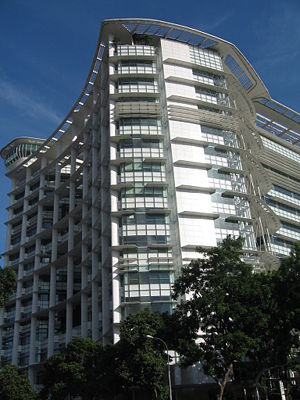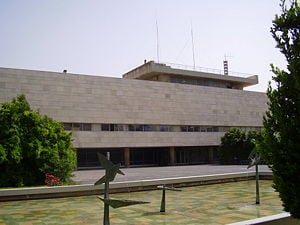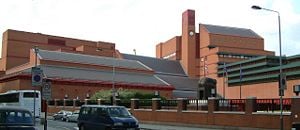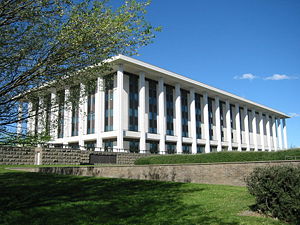National library
A national library is a library specifically established by the government of a country to serve as the preeminent repository of information for that country. Unlike public libraries, these rarely allow citizens to borrow books. Often, they include numerous rare, valuable, or significant works.
The first national libraries had their origins in the royal collections of the sovereign or some other supreme body of the state. National libraries are usually notable for their size, compared to that of other libraries in the same country. Some states that are not independent but wish to preserve their particular culture have established a national library with all the attributes of such institutions, such as a legal deposit.
In the United States the Library of Congress performs many of the functions of a national library and is the de facto national library. The National Library of Medicine and the National Agricultural Library are national libraries for the U.S. within their fields.
National libraries of Europe participate in The European Library. This is a service of The Conference of European National Librarians (CENL).
Library of Congress
The Library of Congress is the de facto national library of the United States and the research arm of the United States Congress. Located in three buildings in Washington, D.C., it is the largest by shelf space and one of the most important libraries in the world. Its collections include more than 30 million catalogued books and other print materials in 470 languages; more than 58 million manuscripts; the largest rare book collection in North America, including a Gutenberg Bible (one of only four perfect vellum copies known to exist)[1]; over one million US Government publications; one million issues of world newspapers spanning the past three centuries; 33,000 bound newspaper volumes; 500,000 microfilm reels; over 6,000 comic book[2] titles; the world's largest collection of legal materials; films; 4.8 million maps; sheet music; 2.7 million sound recordings; more than 13.7 million Prints & Photographs images including fine and popular art pieces and architectural drawings; the Betts Stradivarius; and the Cassavetti Stradivarius. The head of the Library is the Librarian of Congress, James H. Billington.
United States National Library of Medicine
(see main article: United States National Library of Medicine)
The United States National Library of Medicine (NLM), operated by the United States federal government, is the world's largest medical library.[3] The collections of the National Library of Medicine include more than seven million books, journals, technical reports, manuscripts, microfilms, photographs, and images on medicine and related sciences, including some of the world's oldest and rarest works.
Since 1879, the NLM has published the Index Medicus, a monthly guide to articles in nearly five thousand selected journals. The last issue of Index Medicus was printed in December 2004, but this information is offered in the freely accessible PubMed amongst the more than fifteen million MEDLINE journal article references and abstracts going back to the 1960s and 1.5 million references going back to the 1950s.
The NLM also runs the National Center for Biotechnology Information (NCBI) which houses biological databases freely accessible over the Internet through the Entrez search engine and PubMed.
The Toxicology and Environmental Health Program (TEHIP), established at the NLM in 1967, is charged with developing computer databases compiled from the medical literature and from the files of governmental and nongovernmental organizations.[4] TEHIP has implemented several information systems for chemical emergency response and public education, such as the Toxicology Data Network (TOXNET), TOXMAP, Tox Town, Wireless Information System for Emergency Responders (WISER), Toxmystery, and the Household Products Database. These resources are accessible without charge on the Web.
The Extramural Programs Division provides grants to support research in medical information science and to support planning and development of computer and communications systems in medical institutions. Research and publications in the history of medicine and the life sciences are also supported.
United States National Agricultural Library
The United States National Agricultural Library is one of the world's largest and most accessible agricultural research libraries. It serves as a National Library of the United States and library of the United States Department of Agriculture. The library has two locations, the Abraham Lincoln Building on the grounds of the Henry A. Wallace Beltsville Agricultural Research Center, and the DC Reference Center in the Department of Agriculture's South Building in Washington, DC.
The National Agricultural Library was created as the departmental library for the U.S. Department of Agriculture in 1862 and became a national library in 1962. One of four national libraries of the United States (along with the Library of Congress, the National Library of Medicine, and the National Library of Education), it is also the coordinator for a national network of state land-grant and U.S. Department of Agriculture (USDA) field libraries. In its international role, the National Agricultural Library serves as the U.S. center for the international agricultural information system, coordinating and sharing resources and enhancing global access to agricultural data. The National Agricultural Library's collection of over 3.3 million items and its leadership role in information services and technology applications combine to make it the foremost agricultural library in the world.
The library operates the Agricola database of scientific literature.
The National Agricultural Library houses several specialized information centers, which provide access to comprehensive and essential information resources focusing on the specific aspects of agricultural subjects. In addition to the general reference services available at NAL, each center offers Internet access to resources enhancing information availability and dissemination. The centers have staff available to serve customers on-site as well as by phone, fax or email. The Information Centers at the National Agricultural Library include:
- Alternative Farming Systems Information Center
- Animal Welfare Information Center
- Food and Nutrition Information Center
- Food Stamp Nutrition Connection (FSNC)
- Healthy School Meals Resource System
- International Bibliographic Information on Dietary Supplements Database (IBIDS)
- Nutrition.gov
- WIC Works Resource System
- Food Safety Information Center
- Invasive Species Information Center
- Rural Information Center
- Technology Transfer Information Center
- Water Quality Information Center
The European Library
The European Library is an Internet service that offers access to the resources of 47 European national libraries. The resources, both digital and non-digital, include books, magazines, journals, audio recordings and other material. The European Library portal offers free search capabilities and delivers metadata records as well as digital objects: some for free, others at cost. The global management of The European Library is based on a consortium of 23 subscribing national libraries, all in charge of maintaining and developing the portal services.


Legal deposit and copyright
Some countries implement "legal deposit" laws. In the United Kingdom the Legal Deposit Libraries Act 2003 restates the Copyright Act 1911, that one copy of every book published there must be sent to the national library (the British Library); five other libraries (the Bodleian Library at Oxford University, the Cambridge University Library, the National Library of Scotland, the Trinity College Library, Dublin, and the National Library of Wales) are entitled to request a free copy within one year of publication. The international nature of the book publishing industry ensures that all significant English language publications from elsewhere in the world are also included.
In the Republic of Ireland, the Copyright and Related Rights Act 2000 specifies that one copy of every book published is to be delivered to the National Library of Ireland, the Trinity College Library, Dublin, the library of the University of Limerick, the library of Dublin City University, and the British Library. Four copies are to be delivered to the National University of Ireland for distribution to its constituent universities. Further, on demand in writing within twelve months of publication a copy is to be delivered to the Bodleian Library, Cambridge University Library, the National Library of Scotland, and the National Library of Wales.
In Australia, the Copyright Act 1968 and other state Acts requires that a copy of every book published in Australia be deposited with the National Library of Australia, the State Library for each state and certain other libraries such as Parliamentary libraries and University libraries, while in Singapore, the National Library Board Act requires all publishers in Singapore to deposit two copies of every publication to the National Library Board at their own expense within four weeks from the publication date.
A similar system exists in France with respect to the National Library of France; a similar system also exists in Canada with respect to its national library, known as Library and Archives Canada, and in Quebec, the Bibliothèque et Archives nationales du Québec which has been entitled to two copies (for publications retailing at less than $250), or one copy (for publications retailing at $250 or above) of books published in Quebec since 1968.
Since 1661, the Swedish Royal Library has been entitled to a copy of all works published in Sweden.
Other countries, like the United States, do not follow this requirement. The United States does, however, require that any publisher submit two copies of a copyrightable work to United States Copyright Office at the Library of Congress—this is known as mandatory deposit—but the Library is selective about which works it retains. The international nature of the book publishing industry ensures that all significant English language publications from elsewhere in the world are also included. It also has the Federal depository libraries, which must receive a copy of all of the publications of the Government Printing Office.
In addition to having a law requiring publishers to deposit books, those countries with legal deposits usually have many other incentives for a proper and speedy deposit, such as a tie-in with laws affecting copyright of the same documents, and/or a cataloguing- in- publication service.
About three million new English-language books are retained by the British Library and Library of Congress each year.
National bibliographic control
One of the main goals of a national library is to fulfill their nation's part in following the common international goal of universal bibliographic control, by ensuring the bibliographic control of all the books or book-like documents published in, or pertaining to, that particular country.
The first part of the goal is usually achieved through the means of legal deposit laws or (as is the case of the United States) by a host of different programs such as a cataloguing in publication service. By this service, the Library of Congress gives a complete catalogue entry of a book to any publisher who sends a final draft or some form of galley proof of a book currently in production. Other national libraries offer similar services or enforce mandatory practices similar to this.
The second part of the goal is achieved by thorough acquisition programs and collection development policies that target book markets in other nations, which foster international cooperation with other countries with national libraries who have national bibliographic control as one of their goals. Exchange and access protocols are defined permitting these countries to read each other's catalogues and to standardize catalogue entries, thus making it easier for each national library to become aware of every possible published document which might concern their country.
International bibliographic control
Another one of the main goals of many national libraries is the "export aspect" and the collaborative aspect of the universal bibliographic control of all the books in the world. This is done by the exchanges and accords mentioned in the previous section, and also by fostering the creation of standard conceptual tools such as library classification systems and cataloguing rules. The most commonly used of these tools is the International Standard Bibliographic Description or ISBD. It applies to books and periodicals, but also has variants for other book-like material such as the ISBD (ER) for Electronic Resources or digital documents or the ISBD (A) for Antiquarian documents, which were published after the birth of printing but before the industrial era of publishing, which started in the 1820s.
See also
- List of national libraries
Notes
- ↑ See Biblia Latina, Rare book and Special Collections Division, Library of Congress. Europe, Rare Book and Special Collections in American Memory, Library of Congress Home Page. Retrieved May 23, 2008.
- ↑ About the Serial and Government Publications Division The Library of Congress. Retrieved August 8, 2008.
- ↑ M.E. DeBakey (1991), The National Library of Medicine. Evolution of a premier information center. JAMA 266 (9): 1252-8
- ↑ Toxicology and Environmental Health Program. Retrieved July 11, 2007.
ReferencesISBN links support NWE through referral fees
- Allison, Anne Marie, and Ann Allan. OCLC, a National Library Network. Short Hills, N.J.: Enslow Publishers, 1979. ISBN 0894900196 ISBN 9780894900198
- Conaway, James. America's Library: The Story of the Library of Congress, 1800-2000. New Haven, CT: Yale University Press in association with the Library of Congress, 2000. ISBN 0300083084 ISBN 9780300083088
- Hobson, Anthony. Great Libraries. New York: Putnam, 1970.
- Laubier, Guillaume de, and Jacques Bosser. The Most Beautiful Libraries in the World. New York: Harry N. Abrams, 2003. ISBN 0810946343 ISBN 9780810946347
- National Library of Australia. Treasures from the World's Great Libraries. Canberra, ACT: National Library of Australia, 2001. ISBN 0642107394 ISBN 9780642107398
- Pitkin, Gary M. The National Electronic Library: A Guide to the Future for Library Managers. The Greenwood library management collection. Westport, Conn: Greenwood Press, 1996. ISBN 0313296138 ISBN 9780313296130
External links
All links retrieved November 11, 2022.
- Conference of European National Librarians(CENL)
- The European Library
- United States National Library of Medicine
Credits
New World Encyclopedia writers and editors rewrote and completed the Wikipedia article in accordance with New World Encyclopedia standards. This article abides by terms of the Creative Commons CC-by-sa 3.0 License (CC-by-sa), which may be used and disseminated with proper attribution. Credit is due under the terms of this license that can reference both the New World Encyclopedia contributors and the selfless volunteer contributors of the Wikimedia Foundation. To cite this article click here for a list of acceptable citing formats.The history of earlier contributions by wikipedians is accessible to researchers here:
- National_library history
- Library_of_Congress history
- European_Library history
- United_States_National_Library_of_Medicine history
- United_States_National_Agricultural_Library history
The history of this article since it was imported to New World Encyclopedia:
Note: Some restrictions may apply to use of individual images which are separately licensed.

